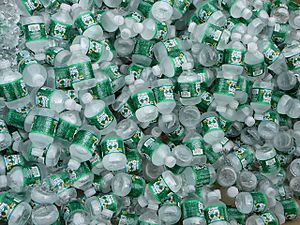Bottled water in the United States facts for kids
Bottled water is drinking water sold in plastic or glass bottles. It has become very popular around the world. The United States buys and drinks more bottled water than any other country. Mexico, China, and Brazil also drink a lot of bottled water.
Not long ago, Americans didn't drink much bottled water. In 1975, people drank only about one gallon per year. By 2005, this had grown to about 26 gallons per person each year. In 2017, sales of bottled water reached $24.1 billion. Americans now drink about 21 gallons of bottled water per person every year. The number of bottled water brands in the U.S. has grown a lot, from 16 brands in 1970 to 195 brands in 2012.
How Bottled Water is Marketed
Water is a natural resource, but bottled water is sold like a product. Companies use clever ways to make you want to buy it. Ads for bottled water often show beautiful natural places. They use words like "pure," "pristine," and "natural." This makes bottled water seem very clean and healthy.
These marketing tricks are important for selling bottled water. They try to make people think bottled water is better than tap water. Some water brands are made for athletes. Others are for children, with special bottles for boys and girls. There are even special waters for pets!
Bottled water companies also make health claims. Some brands say they add "nutraceuticals." These are like vitamins and minerals. You can even find water with nicotine, aspirin, or caffeine added to it.
Rules for Bottled Water
The Food and Drug Administration (FDA) sets rules for bottled water. These rules cover what water can be called, how clean it must be, and how it should be made.
However, one person is in charge of regulating bottled water across the country. Most bottled water (60% to 70%) is sold only within one state. The FDA can only regulate water that crosses state lines. This means a large part of bottled water in the United States is not regulated by the FDA.
Types of Bottled Water
The FDA has rules for what different types of bottled water can be called:
- Ground water: This water must not be directly affected by water from rivers or lakes.
- Mineral water: This water naturally contains more than 250 parts per million of dissolved minerals.
- Artesian water: This water comes from a well that taps into a trapped underground water source. The water level in the well is naturally higher than the top of the water source.
- Purified water: This water has been treated to remove minerals and other substances. Methods include distillation or reverse osmosis.
- Sparkling water: This water has the same amount of carbon dioxide as it had when it came from its source. The carbon dioxide might be removed and then added back during treatment.
- Spring water: This water must come from an underground place where water naturally flows to the Earth's surface.
- Sterile water: This water meets very strict rules for being completely free of germs.
- Well water: This water is taken from a hole drilled into the ground that reaches an underground water source.
The FDA also sets rules for how clear water should be. They check its color and smell. These rules are about how the water looks and smells, not usually about health risks. For example, mineral water can have a natural color and still be sold.


